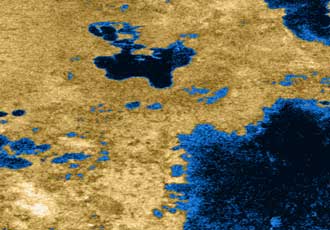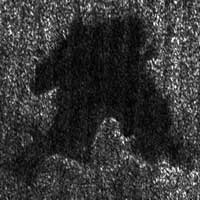Some of the lakes appear dry, while others appear full of liquid. Some of the half-full lakes were probably never completely full, or partially evaporated several times in the past. Even the dry lakes have shores or basins and their clarity on the radar is similar to that of the rest of the surrounding area, which indicates the absence of liquid

Pictured: An artificially colored image showing the lakes on Titan. The color density is relative to the brightness returned by the radar. The deer do not represent what the human eye can see. Underneath - this is how the radar sees it
Scientists reported last week in the journal Nature conclusive evidence for the existence of lakes filled with liquid methane on the Saturnian moon Titan. Radar images taken by the Cassini spacecraft during its flyby of Titan  On July 22, 2006, provided compelling evidence for the existence of large bodies of liquid on Titan. A color image released now gives a sense of what Cassini saw.
On July 22, 2006, provided compelling evidence for the existence of large bodies of liquid on Titan. A color image released now gives a sense of what Cassini saw.
Characteristics of the lake:
Dark patches returned by the radar are interpreted as lakes whose radar reflectivity is low and whose morphology is similar to lakes on Earth, including canals and location in topographic depressions. These bodies are also very smooth and likely contain liquid, rocks, ice or organic materials. In the photographs you see over 75 dark spots or lakes, whose size ranges from 3 kilometers to over 70 kg.
Some of the lakes appear dry, while others appear full of liquid. Some of the half-full lakes were probably never completely full, or had partially evaporated several times in the past. Even the dry lakes have shores or basins and their clarity on the radar is similar to that of the rest of the surrounding area, which indicates the absence of liquid.
The changing states of filling the lakes show that the lakes in the same area on Titan may empty sometimes, but we do not know what the time scale is in which the phenomenon occurs.
About 15 of the lakes appear full and show no evidence of erosion. These dark spots are reminiscent of terrestrial lakes that fill impact craters, such as Clearwater Lakes in Canada, or within volcanic craters (Crater Lake in Oregon). The turbulent nature of these lakes and the slight variation in their size makes the hypothesis that they originate from impact craters implausible. A volcanic origin of these sockets is not ruled out, mainly due to their shape.
Dark patches near the shores of lakes can be small islands rising above the surface. "Floating icebergs" are out of the question because most materials will not be floated by liquid hydrocarbons.
Additional observations:
Based on the characteristics of the lakes, Cassini scientists believe they are observing lakes that are currently full of liquid. Another possibility is that these depressions and channels were formed in the past and have now been filled with low-density liquid reservoirs (condensation of the atmospheric material) and due to the low density they are darker than the other formations observed on Titan. However, the absence of formations originating from the blowing of the wind in those areas lowers the chance for the low density theory.
The concentration of lakes in the northern hemisphere is strong evidence that Titan's surface and atmosphere are involved in an active hydrological cycle, even though the liquid is not water. In this cycle, the lakes are filled with methane gases or come into contact with layers saturated with liquid methane.
As the seasons on Titan progress in Saturn's 29-year orbit around the Sun, the lakes in the winter hemisphere should expand due to continuous methane rain, while the lakes in the summer hemisphere will shrink, or even dry up completely.
For information on the NASA website

One response
To Abby Bilowski why Huggins didn't find out